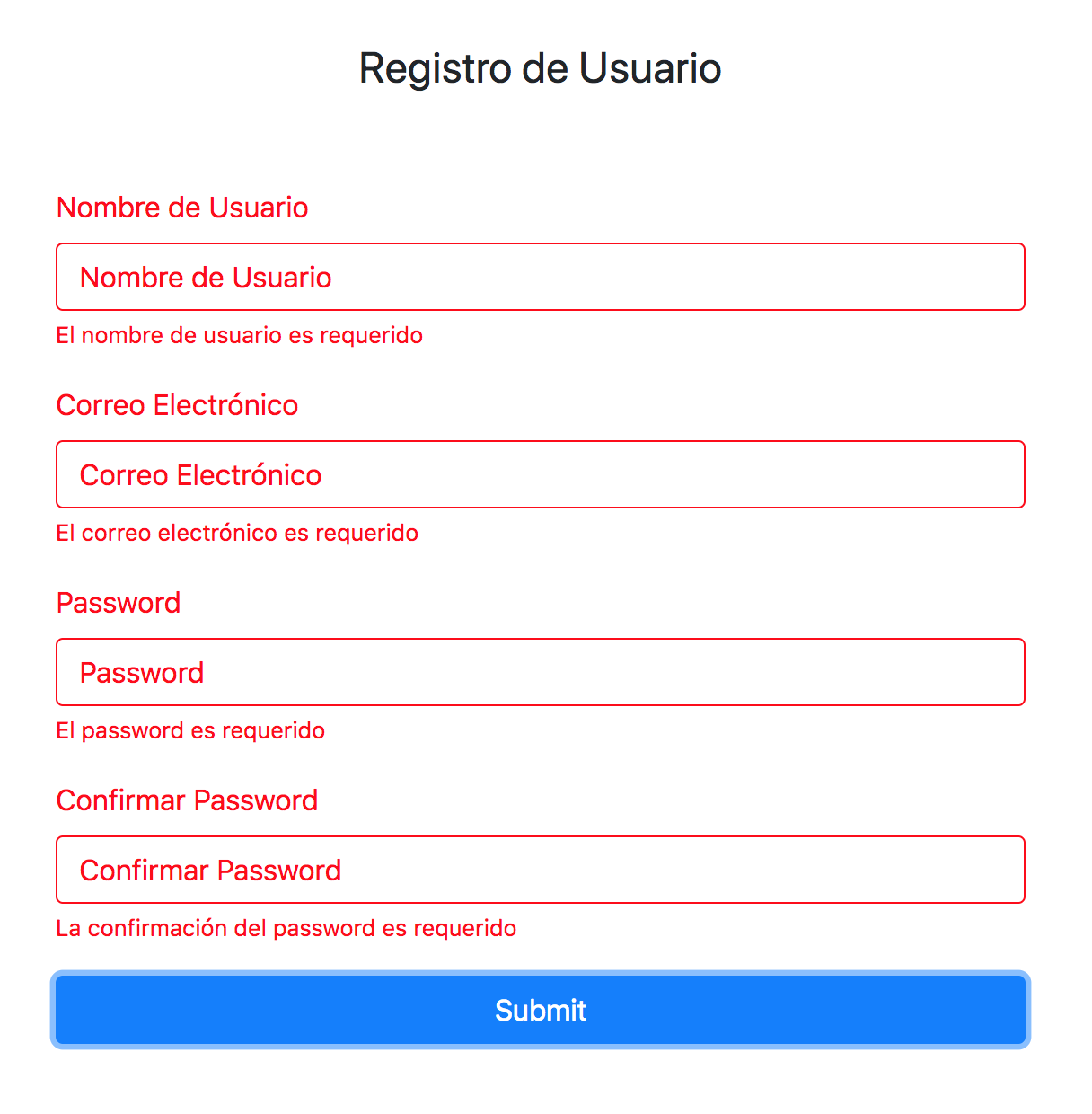How to Create a Register Form with Angular 6
In this post I share with you How to Create a Register Form with Angular 6 easy using bootstrap 4, it includes a simple validation but it helps you to understand how to validate forms with Angular
1. Create the Registration Component
In order to create our component let’s use ng cli to create the scaffold of the component using the following component
ng generate component Register
It will generate the files we need to create the form layout and validation.
2. Add HTML Markup
Let’s add the markup to support the form in order to do this check this code below:
1
2
3
4
5
6
7
8
9
10
11
12
13
14
15
16
17
18
19
20
21
22
23
24
25
26
27
28
29
30
31
32
<div class="row">
<div class="col-lg-6 col-12 mx-auto my-5">
<fieldset class="form-group">
<legend class="text-center mb-5">Registro de Usuario</legend>
<form [formGroup]="registerForm" (ngSubmit)="onSubmit()" >
<div class="form-group" [ngClass]="{'form-group-error': submitted && f.username.errors }">
<label for="username">Nombre de Usuario</label>
<input type="text" formControlName="username" class="form-control" id="username"
placeholder="Nombre de Usuario" >
<small class="form-control-feedback" >El nombre de usuario es requerido</small>
</div>
<div class="form-group" [ngClass]="{'form-group-error': submitted && f.email.errors }">
<label for="email">Correo Electrónico</label>
<input formControlName="email" type="email" class="form-control" id="email" placeholder="Correo Electrónico">
<small class="form-control-feedback" >El correo electrónico es requerido</small>
</div>
<div class="form-group" [ngClass]="{'form-group-error': submitted && f.password.errors }">
<label for="password">Password</label>
<input formControlName="password" type="password" class="form-control" id="password" placeholder="Password">
<small class="form-control-feedback">El password es requerido</small>
</div>
<div class="form-group" [ngClass]="{'form-group-error': submitted && f.passwordConfirm.errors }">
<label for="passwordConfirm">Confirmar Password</label>
<input formControlName="passwordConfirm" type="password" class="form-control" id="passwordConfirm" placeholder="Confirmar Password">
<small class="form-control-feedback" *ngIf="f.passwordConfirm.errors?.required">La confirmación del password es requerido</small>
<small class="form-control-feedback d-block" *ngIf="f.passwordConfirm.errors?.MatchPassword">Passwords no son iguales</small>
</div>
<button type="submit" class="btn btn-block btn-primary">Submit</button>
</form>
</fieldset>
</div>
</div>
Code Explanation
In this code we use f as a getter to return the form.controls variables for easy use.
The ng-class is used to display if the form has an error and we add the class .form-group-error to the entire group so we can control using css
Match Passwords Custom Validation
To Validate the pasword and password confirmation are equals we want to create a new class in order to do that we run the command:
1
ng generate class PasswordValidation
And then we use this code to validate the password using the same values as the fields defined in the html markup
1
2
3
4
5
6
7
8
9
10
11
12
import { AbstractControl } from '@angular/forms';
export class PasswordValidation {
static MatchPassword(ac: AbstractControl) {
let password = ac.get('password').value; // to get value in input tag
let passwordConfirm = ac.get('passwordConfirm').value; // to get value in input tag
if (password != passwordConfirm) {
ac.get('passwordConfirm').setErrors({ MatchPassword: true })
} else {
return null
}
}
}
Form validation using Angular
First We’re going to copy the validation class in the generated register.component.js file as follows:
1
2
3
4
5
6
7
8
9
10
11
12
13
14
15
16
17
18
19
20
21
22
23
24
25
26
27
28
29
30
31
32
33
34
35
36
37
38
import { Component, OnInit } from '@angular/core';
import {FormBuilder, FormGroup, Validators} from '@angular/forms';
// this is the custom validation for password match
import { PasswordValidation } from './../password-validation';
@Component({
selector: 'app-register',
templateUrl: './register.component.html',
styleUrls: ['./register.component.css']
})
export class RegisterComponent implements OnInit {
registerForm: FormGroup;
submitted:boolean = false;
constructor(private formBuilder: FormBuilder) { }
ngOnInit() {
this.registerForm = this.formBuilder.group({
username: ['', Validators.required],
email: ['', [Validators.required, Validators.email]],
password: ['', Validators.required],
passwordConfirm: ['', Validators.required]
}, {validator:PasswordValidation.MatchPassword})
}
get f(){
return this.registerForm.controls;
}
onSubmit() {
this.submitted = true;
if(!this.registerForm.valid){
console.log('not valid');
return;
}
alert('Success');
}
}
Code explanation
- We imported the required modules provided by angular/core which will help us to define the group builder.
- We imported also
PasswordValidationclass, this class will help us to validate the password confirmation (it will be provided next) - We defined two private variables
registerForm(of type FormGroup),submitted(flag to be set when the form is submitted) - On
ngOnInit()we assign to the private variable defined registerForm and provide the rules of each field by name defined in the markup asformControlName - We define a custom validator it helps us to validate that the passwords matches.
- Definition of
onSubmitmethod that will check if the form is valid or not and is also added to the markup(ngSubmit)="onSubmit()". It mark flag is submitted to true and then verify if the registerForm (created on ngOnInit method) is valid if not will show the errors already defined in the markup. On each<small>tags.
And that’s it it will generate a form like this
Form validation

Thanks for reading this post hope it help you a bit to understand forms in angular. Have an amazing day!
Jay